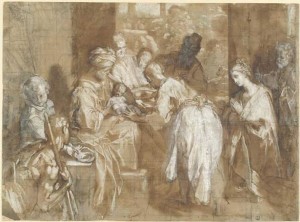
Di Maria Maddalena Grossi (Università degli studi di Firenze)
Il Gabinetto Disegni e Stampe degli Uffizi (GDSU) prevede tra le iniziative espositive un progetto chiamato “Euploos”, ovvero l’esposizione periodica nella Sala Detti, al primo piano della Galleria degli Uffizi, di opere provenienti dalla sua prestigiosa collezione. In questi mesi è possibile ammirare una mostra dedicata ai disegni preparatori, ma anche agli schizzi e ai pensieri messi su carta da Federico Barocci (Urbino 1533-1535/1612). Il Barocci fu uno dei pittori più importanti del periodo della Controriforma, nacque ad Urbino ma, come la maggior parte degli artisti di quel periodo, si formò a Roma sotto la guida di Taddeo Zuccari, ispirandosi ai grandi maestri del Cinquecento: in primis Raffello, ma anche Michelangelo. La sua pittura, oltre che di Raffaello, risente di Correggio che probabilmente ebbe modo di vedere a Roma, ma giunge ad una posizione artistica assai originale sia per la raffinata interpretazione del colore e della composizione dei grandi maestri del Rinascimento, sia per la sottile vena sentimentale. Dopo il periodo romano tornò ad Urbino dove continuò a lavorare per i committenti di tutta Italia.
La mostra intitola Fucina delle immagini, vuole proprio focalizzare l’attenzione su le idee che nell’artista urbinate prendevano forma, come un laboratorio grafico che nella maggior parte dei casi si è poi concretizzato con le opere a noi oggi note del Barocci.
La mostra si suddivide in tre sezioni: la prima è incentrata sulle modalità costruttive della figura, sui movimenti e su parti del corpo umano indagate e studiate come esercizi disegnativi; non mancano molteplici riferimenti a fonti e prototipi (come la statuaria), l’elaborazione mentale e lo studio della figura dal vero. La cosa interessante di questa sezione è la presenza di due parti che si uniscono nella creazione della figura, ovvero lo studio dal vero e il processo mentale o “studio da sè” frutto dell’immaginazione e della memoria visiva.
La seconda parte intende porre l’attenzione sul processo successivo allo studio della figura, ovvero l’atteggiarsi dei movimenti con i panneggi e l’indagine luministica. È presente in questi disegni anche la ripetizione della stessa figura e quindi il verificare le diverse angolazioni, ciò che si viene a creare è la simulazione del movimento in uno stesso foglio di carta che arriva a formare una vera e propria sequenza cinematografica.
La terza sezione è dedicata a cinque studi compositivi, quindi ad intere scene alle quali si è giunti grazie alle due sezioni precedenti. Tra questi spiccano i due fogli preparatori per gli affreschi del Casino di Pio IV, dove dall’indagine dell’intera scena segue lo studio su una sola parte di essa.
La mostra, non è molto grande, consiste delle sole quattro pareti della sala Detti, ma è gratuita e permette di conoscere il Federico Barocci disegnatore, che fu uno degli artisti più fruttuosi in questo genere nel periodo della Controriforma, di lui infatti esistono più di 2000 disegni.
Translation by Bethany Hucks (Istituto Lorenzo De’ Medici)
The Cabinet of Drawing and Prints of the Uffizi (GDSU) offers among its exhibitions a project called “Euploos”, a temporary exhibition in the Dictation Room on the first floor of the Uffizi Gallery, of works originating from their own prestigious collection. In these months, it is possible to view a show dedicated to the initial designs as well as the preparatory sketches and drafts put on paper by Federico Barocci (Urbino, 1533/1535 – 1612). Barocci was one of the most important painters of the Counterreform Period, born in Urbino but, like most of the artists of this period, trained in Rome under the guidance of Taddeo Zuccari, inspiration to the grand masters of the sixteenth century – primarily Rafael, but also Michelangelo. Barocci’s painting was inspired not just by Rafael; his way of seeing Rome was affected by Correggio, but adds a very original artistic viewpoint both by the refined interpretation of color and composition of the great masters of the Renaissance and the subtle sentimental streak. After his Roman period he returned to Urbino, where he continued to work for customers all over Italy.
The exhibition, titled Forging Effigies, aims primarily to focus attention on the ideas that took form in Urbino artists, like a visual laboratory that in many cases were fully formed with works that today we know are Barocci’s.
The show is divided into three sections. The first is focused on the method of constructing the human figure, and on the movement and parts of the human body, surveyed and studied as design exercises. It includes multiple references to sources and prototypes (like statuary), mental processes, and the study of human figures from life. The interesting portion of this section is the presence of two parts that unite in the creation of an illustration; that is a life study and the mental process or “self-study” produced from imagination and visual memory.
The second part intends to place attention on the successive processes in figure studies, that is the roleplaying of movements with drapery and the study of light. The repetition of the same figure is present in these designs, and therefore the testing of different angles, which comes to create a simulation of movement on a single sheet of paper that forms a true cinematographic sequence.
The third section is dedicated to five composite studies, which as complete scenes are put together using the two previous sections. Among these works, the two pieces prepared for the frescoes of the Lodge of Pious IV stand out, wherein the study of the entire scene becomes the study of only a part of it.
The display is not very large, consisting only of the four walls of the Dictation Room, but is free, and introduces Federico Barocci as a draftsman who was one of the most prolific artists of this genre in the Counterreform Period; in fact, we still have more than 2,000 of his works.